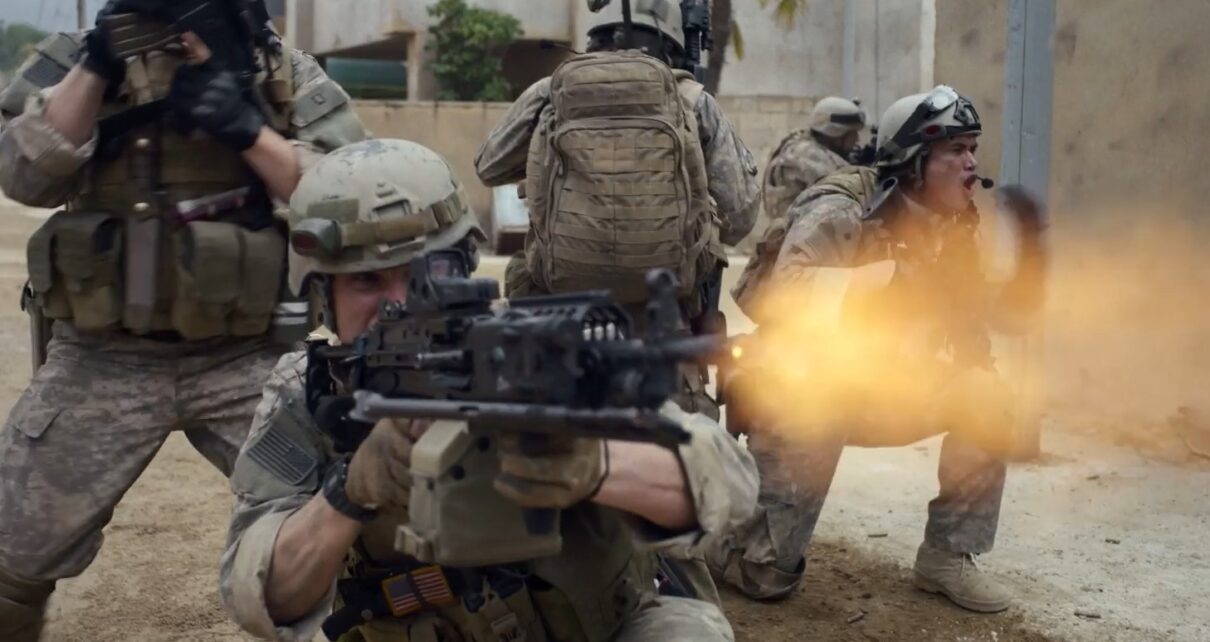It’s important to remember that this entire conflict hinged on a lie. Yes, we didn’t like Saddam Hussein, and, yes, -all else being equal- the world is a better place without him. BUT, all else is not equal, AND, the United States invaded Iraq on the premise that Saddam had something to do with 9-11. He did not. He might have wished for it or cheered it on, but he didn’t have anything to do with it. And invading Iraq on this premise or any other we used to justify it at the time, was a lie. A BIG FAT LIE.
And this became an important stepping-stone in US History, because it represented the moment Republicans realized they no longer needed to present the truth to get what they wanted. And since Trump showed up, they never have.
But I digress.
Warfare is about … Warfare. The film is a biographical re-creation of a conflict involving American soldiers in Ramandi over a one-day period in 2006. This really happened … or, at least, the movie seems an honest re-telling of the events as they happened. As there is little propaganda, jingoism, or flag-waving to be found in the film, I’m inclined to take it a face value, which means the real-life intensity of the situation is hard to match.
The good news is that during the night, about a dozen US soldiers infiltrated and took over a residential Iraqi home with a minimal amount of alarm or damage. They did so to spy on the market across the street.
The bad is EVERYBODY KNOWS THEY’RE THERE. Despite the cover of night and the shield of walls, the bad guys all seem to know American soldiers are hanging out at Abdullah’s crib. I have no idea what the tip-off was, but no Iraqi opponent was confused about what was going on. Several reports on the marketplace offered opinions about whether they’d been made. Soon to be armed men were “peeking with serious intent to probe.” Worth note that this conflict is entirely told from the American POV. We don’t meet the enemy at any time. We have no idea how strong they are, what their grand strategy is, or how much damage they take when Americans fight back.
Act I is the hush of war. After -guessing- several hours of “ho hum,” the opposition announced itself by tossing a flash grenade into the second story hole the American sniper peeked out of. And at that moment, the entire rest of the film can be reduced to two words: intensity and chaos.
Well, “chaos” may be a little exaggerated; the soldiers knew their objective and tried to keep order, but they were surrounded by enemy converging from every neighboring rooftop. This is definitely an intense film; we get a very good look as to what war is like in reality. It is passionate and ugly … and a constant search for order among chaos.
were surrounded by enemy converging from every neighboring rooftop. This is definitely an intense film; we get a very good look as to what war is like in reality. It is passionate and ugly … and a constant search for order among chaos.
As stated above, it is important to note: this is the price of lies. There wasn’t any good or truthful reason for US soldiers to be in Ramandi in March of 2006. I do not, however, think that takes anything away from the intensity or effectiveness of the film. None of the soldiers are espousing politics in this moment; they’re just doing what soldiers do: following orders, supporting one another, and trying to stay alive. On that score, Warfare is 100% effective. On the score of effectively identifying any trait of a soldier other than “soldier” or even introducing a single opponent, the film is less effective – but perhaps that’s the point. When you are part of a unit, you don’t necessarily have an individual identity, what you have is your brother’s back. And that is where Warfare shines. It’s not Saving Private Ryan by any stretch, but Warfare can match Ryan’s intensity when it needs to.
There were once US soldiers in Iraq
All grateful to have one another’s back
For their camaraderie
Compensated, you see
For the proper rationale they’d all lack
Rated R, 95 Minutes
Director: Alex Garland, Ray Mendoza
Writer: Alex Garland, Ray Mendoza
Genre: Real life stuff
Type of being most likely to enjoy this film: Veterans
Type of being least likely to enjoy this film: Pacifists



